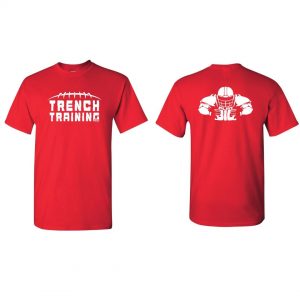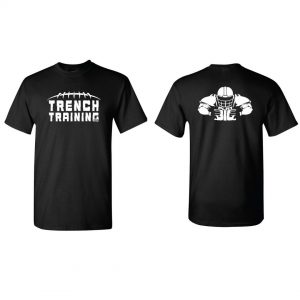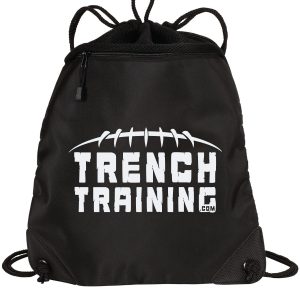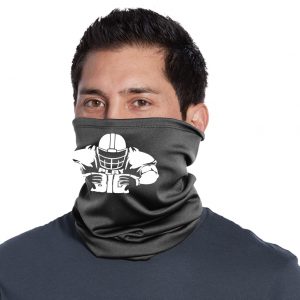
by Steve Stark | Dec 6, 2016 | player development
Peer pressure in teens today I think can better be described as peer influence.
It’s less about being pressured to something against your will.
I believe kids are stronger willed today than ever before and have much more information to draw from when making choices.
Peer pressure is more about being influenced by the actions or words of your peers.
What is Mary wearing to school?
What kind of phone does Jimmy have?
Where does the star quarterback hangout on the weekend?
Does cool guy Brady drink alcohol and do drugs?
While I’m sure there is some “pressuring” regarding these things, I think the it’s more about the influence of seeing others taking these actions.
Parents Dealing with Peer Pressure in Teens
Open communication.
Stay up with your child’s life.
Be involved in what they are interested in.
Keep talking to your teenager.
Even if they seem disinterested in talking to you, they like that you are interested in them.
They need feel comfortable speaking to you.
Give your child a way out.
Let you child know that they can call you when they are in a difficult peer pressure situation.
They need to know that you are not going to blow up at them for being in that situation.
You have to be there for them without the immediate judgement or reaction.
Let them know that you are there for them no matter what and it’s okay to call or text if they are uncomfortable.
Build their self esteem.
Part of becoming an independent person is having a belief in yourself.
As parents, we can do so much to instill self esteem.
It starts with a positive message to our kids.
Help your child set goals and make sure they are realistic and attainable.
They need to know that they can accomplish their goals.
Celebrate their successes and continue to encourage them when they fail.
Failure is necessary for growth and overcoming failure is the fastest way to build self esteem.
Encourage a wider base of friends.
Friendships sometimes go bad.
Hurt feelings happen often in the teen years.
That’s why it’s good to make friends in different areas of your life.
School, neighbors, activities and sports are all great sources of friendships.
It’s good to be plugged into a couple groups of friends that can offer support.
How Teens Can Deal with Peer Pressure
Get away from the pressure.
You need to be okay walking away from a situation that is uncomfortable.
Walk away and don’t allow someone to apply peer pressure.
It’s not easy but it’s your best option in a difficult situation.
Use the buddy system.
It’s great to say, “just walk away”.
It’s another thing to actually do it.
Having someone by your side to support your decisions can make walking away infinitely easier.
Find a friend that shares your values and beliefs.
Back each other up and it will be far easier to walk away from a difficult situation with that friend by your side.
Seek out positive role models.
What qualities make a person great?
To find out we have to look at great people.
Who do you want to be?
Who is that you can look at and say, “those are the qualities and traits that I want to emmulate”?
Seek those people out and figure out what makes them successful.
Just be careful that you choose wisely.
Emulating the wrong characteristics will land you somewhere you don’t want to be.
Not everyone’s doing it.
Never fall for the line, “It’s okay. Everyone’s doing it.”
They’re not!
Don’t pressure others.
You don’t want to be pressured into things so don’t do it to others.
Set a positive example.
Be the person you wish others would be.
Find new friends.
Jim Rohn said it best.
If you don’t like the person you are then you need to take a hard look at those you hang out with.
Peer pressure in teens is happening every day.
The influence is subtle and compounds over time.
Sometimes we don’t even see it.
Our behaviors, our attitudes towards others, the way we walk, the way we dress and even the way we talk are influenced by our environment.
Be sure that you keep the right people around you.
Not all peer pressure is bad.
Certainly, if we choose the right people to have around us we can be influenced in a positive.
Choose wisely and become the best version of YOU.
If you you found value with today’s post please like, comment and share.
Play Big!

Coach Steve
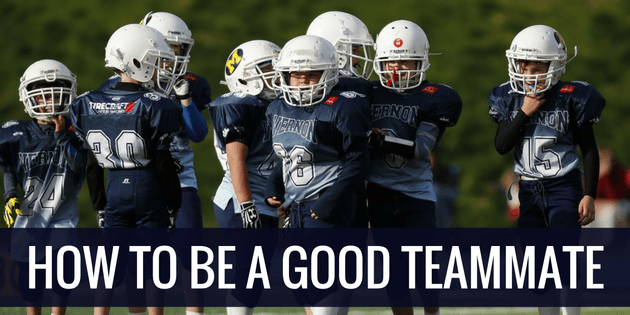
by Steve Stark | Nov 29, 2016 | player development, teamwork
One of the great things about football is that it teaches you how to be a good teammate.
This is a lesson that serves us our entire lives.
We’ve all heard about the chemistry of great teams.
It’s not something you can see or measure but it’s there.
It’s always there in great teams.
First and foremost this chemistry requires good teammates.
It’s impossible to have a great team without them.
Let’s look at some of the traits of how to be a good teammate.
Good Teammate Traits
Honesty
Being part of a team requires good relationships.
Part of any good relationship is the ability to be honest with one another.
Sometimes that means calling guys out when they are not doing the right thing.
This is tough but you can’t have a great team without honesty.
It also requires you to be honest with yourself.
Can you call yourself out when the time comes?
Trustworthy
Building trust takes time.
Honesty is a big part of being able to trust someone.
Teammates also need to know that can trust that you are going to do the right thing.
Both on and off the field.
As a football player, each teammate must trust the man next to them.
Your teammates have to trest you to do your job.
Respectful
Great teams are built on respect.
You have to have respect for your coaches, your teammates, the officials and the fans.
A lack of repsect is a cancer on a team.
Without respect you can’t gain trust and that makes it very difficult to have success on the field.
Supportive
Every team faces adversity.
In many cases, that adversity comes directly to individual players.
A running back fumbles.
A defensive back blows a coverage.
A wide receiver drops a touchdown pass.
A kicker misses a game tying field goal.
Whatever the adversity is, your teammate will need to be lifted up.
You have to have their back.
Selflessness
Can you give without getting back?
Can you sacrifice for your teammates?
As a lineman, you have to e a selfless player.
You aren’t going to get all the accolades that a QB, Running Back, WR, Linebacker or DB might get.
The question you should continue asking yourself is, “What can I do for my team?”
Never, “What can my team do for me?”
Accountability
Are you able to let others hold you accountable?
It can’t just be words.
Actions are what make things happen.
Your coaches and teammate need to hold you accountable for your actions or lack of actions.
Dependable
Will you do what you say you’re going to do?
Can your teammates depend on you to do your job every time?
Being dependable will serve you your entire life.
Whether it’s being dependable for your team, your job, or your family, it speaks to your character.
So what kind of teammate are you?
Which of these traits do you need work on?
Keep these traits of how to be a good teammate in mind for your next season.
If you you found value with today’s post please like, comment and share.
Play Big!

Coach Steve
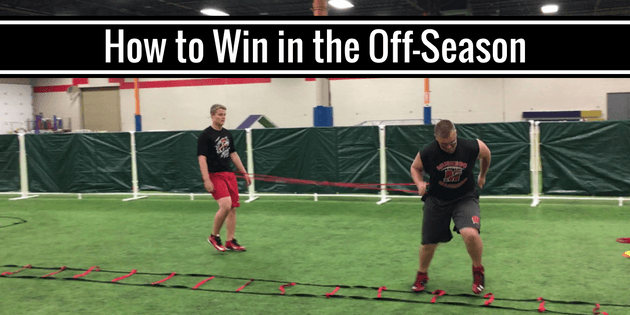
by Steve Stark | Nov 15, 2016 | player development, training
We often get the question, “What should my kid be doing during the off-season?”
A football season takes a great deal from a player both physically and emotionally.
Fo young players and old, it’s important to decompress a little.
Taking a couple weeks off is actually great for your body.
All the bumps and bruises get healed up and we get back to normal physically.
The emotional drain on a player also demands some recovery time.
As a 3-sport athlete in high school I was always pretty worthless the first week of basketball.
Only time and rest can give you the recovery you need.
So what do we do once our healing is done?
Here are some tips to have the best off-season possible.
4 Ways to Have a Great Off-Season
Play other sports.
Take advantage of every chance you get to compete in athletics.
The experience of competing against other drives your development as an athlete.
There are things you learn in competition that cannot be learned any other way.
Sportsmanship, effort, game intelligence, and the ability to deal with adversity are just a few.
There’s also a huge benefit physically to playing other sports.
As a football player, basketball had a significant impact on improving my footwork and overall athleticism.
Every sport requires a different set of athletic skills and ability.
When you take advantage of this physical development it will significantly improve your athleticism.
Check out our previous article on the Advantages of Being a Multi-Sport Athlete.
Drill the skills.
Every position on the football field has a set of skills that need to worked.
This is the biggest deficiency that we see in the development of linemen.
Just because we don’t throw, catch or kick the football does not mean we cannot develop skills for our position.
Stance, take-off, punch, footwork, pass sets and pass rush moves are all skills that should be repped in the off-season.
Improve your craft. Drill the skills!
Stay focused on school.
As a high school coach for many years, I saw many kids fall off in school when the football season ended.
What many of them didn’t realize was that there spring grades effected their eligibility for the following season.
The majority of high schools across the country begin their season prior to the start of school.
In Wisconsin, our teams play two games before the start of the school year.
Very few athletes go on to play college sports.
According to NCAA.org statistics from the 2014-2015 season, 2.6% of high school football players moved on to play in NCAA Division I programs.
Of those players in NCAA Division I football only 1.6% went on to the NFL.
While we love to encourage kids to dream big, it should never be at the expense of their education.
Stay focused on school and be a great student and citizen.
Create a plan.
Give some thought to what you want to accomplish during your off-season.
Think about who you wan to be when you start training camp next fall.
Envision it.
What do you weigh?
How strong are you?
How fast are you?
What does your footwork, punch, stance, and take-off look like?
Really give it some thought and then write it down.
I know… you think that sounds weird and crazy, right?
WRONG!
You have the power to become the best version of yourself.
If you can conceive it, you can achieve.
Writing it down makes it real.
It holds you accountable to yourself.
Give it a try and let us know how that works for you.
Remember, it’s okay to dream big.
In fact… it’s a must if you want to PLAY BIG!
If you you found value with today’s post please like, comment and share.
Play Big!

Coach Steve

by Steve Stark | Nov 8, 2016 | coaching kids, player development
What does “B Team” mean in youth sports?
It can actually mean different things in different youth sports programs.
When we talk about A and B teams, most youth sports programs attempt to divide teams by talent levels.
Programs will evaluate the players they have and rank them based on talent level.
For instance, let’s say you have 50 kids trying out for a 6th grade youth football.
The program would evaluate and rank those kids 1 to 50.
While the program has to take into account numbers at each position this gives them a guideline to break up the teams.
Some programs split their players up equally based on talent level.
So which model is better?
That is a very difficult questions.
A/B Team Model vs. Equal Split Model
Kids develop at such different rates.
It’s impossible to say how good a player is going to when they are just in 5th or 6th grade.
We may get an idea but no one really knows.
The focus at this level should be to keep kids in the game.
So there are couple ways to look at how we deal with multiple teams in a single grade level.
Lets look at the advantages and disadvantages of the A/B team model.
A/B Team Model
Advantages:
Kids practice with athletes with a similar level of skill.
Competition in games is more closely matched.
More playing time.
Disadvantages:
Kids are not challenged by better athletes.
Coaching may not be as good.
Kids may lose interest if they feel they won’t play in the future.
Kids can be mean and feelings can get hurt.
Being a Parent of a B Team Player
More times than not it’s the parents that have more trouble dealing with their player being on the B team than the actual player.
Kids at the youth levels want to have fun.
How many times has your child been more worried about where they are going to get ice cream after the game that the game itself?
Our kids don’t often care if they are on a B team as long as they are having fun.
As a parent fun should be our first priority for our players.
After that we should be looking for them to continue to learn the game.
Your child will take their cues from you.
A couple years ago my daughter did not make the A team for basketball.
I have to say that I was disappointed.
My daughter didn’t let it phase her a bit.
She was happy because a couple of here closest friends were on that team.
So I trusted that those who evaluated her knew that she belonged on the B team.
And she was happy.
Looking back on that, it was the best decision for her.
She played that year at a high level on the B team.
Gained a ton of confidence, developed her skills and made the A team the following year.
The point with this story is that kids develop in different ways and at different times in their lives.
If I would have blown up and showed my disappointment who knows how she would have reacted.
Instead, my wife and I supported her and told her to have fun playing.
At the youth level, the most important thing is to keep kids playing.
Keep kids wanting to play.
Keep kids having fun playing.
As parents, we need to keep our egos in check.
Make sure that what’s happening is right for your child and not what’s right for you.
If you you found value with today’s post please like, comment and share.
Play Big!

Coach Steve
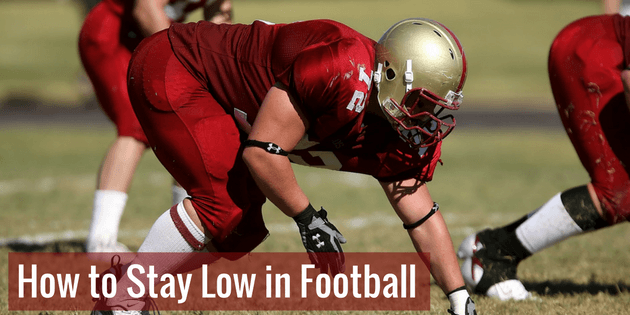
by Steve Stark | Nov 1, 2016 | player development, training
Learning how to stay low in football is the key to success in the line.
“LOW MAN WINS!”
Every football player has heard a coach say this.
So why is that low man wins in football?
It’s all about leverage.
Players who can stay low will play with leverage.
Leverage allows players to take advantage of their lower body strength.
We often talk about teaching kids to be knee benders and not waist benders.
Waist benders have no power and therefore no leverage.
This is why we see smaller players sometimes dominate larger opponents because they play low and maintain leverage.
Let’s look at some things we can teach how to stay low in football.
How to Stay Low in Football
Start with a good stance.
Whether on offense or defense, we look for good bend in the knees and a stable, balanced stance.
Offensive linemen need to get there but down and play with a flat back.
We also want as much of their feet in the ground as possible and a minimal amount of weight on their down hand.
This allows the offensive lineman to release in any direction.
For defensive linemen, we look for more weight on their hand and their butt up a little.
This is a bit more of track stance to get off the ball and disrupt.
Of course, different offenses and defenses may want different approaches but this is a general rule.
Either way pad level coming off the ball has to be a huge factor in stance setup.
Build core strength.
Athleticism is based in the core.
Our definition of the core includes the hips up to just below the chest wrapping around the entire the body.
It’s not just abs!
The core includes not only the abdomen but the hips, obliques and lower back.
It also includes all the small stabilizing muscles around the spine.
Everyting in the core is not only essential for athletic ability but also injury prevention.
In order to play with low pad level the core needs to be very strong and stable.
Continually work on hip flexibility.
We discussed this recently but it cannot be emphasized enough.
While we consider hips to be a part of the core it requires extra attention.
Without the proper hip hinge and flexibility we cannot play low.
The hips are what allow us to bend properly at the knee while keeping a flat stable back.
This helps us to use our powerbase for leverage with form that keeps us healthy.
Repetition, Repetition, Repetition.
The way to play low is to train low and practice low.
Repetition is the only way we condition our bodies to play with good pad level.
How we train and maintain our flexibility every day of the off-season will have an effect on our pad level during the season.
Spending the time on stance, core strength and hip flexibility will determine our ability to play low.
If you you found value with today’s post please like, comment and share.
Play Big!

Coach Steve
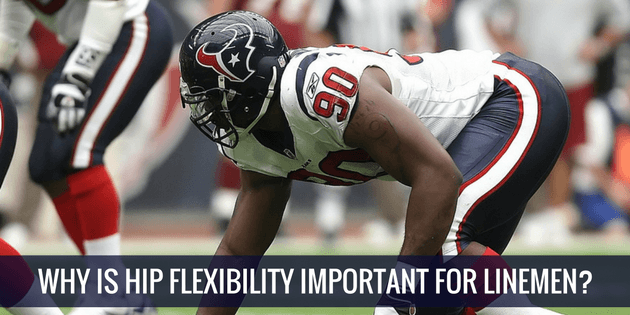
by Steve Stark | Oct 18, 2016 | player development, training
Hip flexibility is the number one thing we at Trench Training hear about from college coaches.
How are their hips?
Do they play with their pads out?
Can they change direction?
These are some of the most common questions college coaches are asking when they watch video of recruits.
Size, strength and power all factor in to be an elite football player.
But hip flexibility is one of the key components coaches look for.
So why is hip flexibility important?
3 Benefits of Good Hip Flexibility
1. Injury prevention.
A lack of flexibility in the hips can have an impact on lower back health.
This is especially prevalent in the weight room.
Without the proper range of motion, an athlete’s form is compromised and the risk of injury increases.
We need our athletes to stay healthy and flexibility is a key component to preventing injury.
2. Improved agility and balance.
You might think agility is not a word often used with linemen.
Maybe defensive linemen but not offensive linemen, right?
Wrong.
Speed may not be a prerequisite to play in the line but agility is.
Lateral movement and quickness are a huge part of being an elite linemen.
Footwork and body position are essential for both blocking and defeating a block.
Agility and balance are also how linemen create leverage and gives them the ability to “play low”.
Playing low allows us to utilize the strength in our legs and glutes giving us a powerful base.
3. Increased explosiveness.
You have probably heard the saying, “low man wins”.
Again, playing low is going to give us a the ability to coil and become explosive off the line.
If a player is more explosive off the ball then their opponent they will have a distinct advantage.
Utilizing leverage and explosiveness, a player can compete with opponents that are bigger and stronger they are.
Hip flexibility is essential to gaining explosiveness.
What is the hip hinge?
Here’s the best definition I’ve found for the hip hinge and it’s from BreakingMuscle.com.
“A hip hinge is movement (flexion and extension) through the hip joint, keeping a neutral spine and the knees slightly flexed.”
A great way to test the hip hinge is to do the dowel hip hinge test.
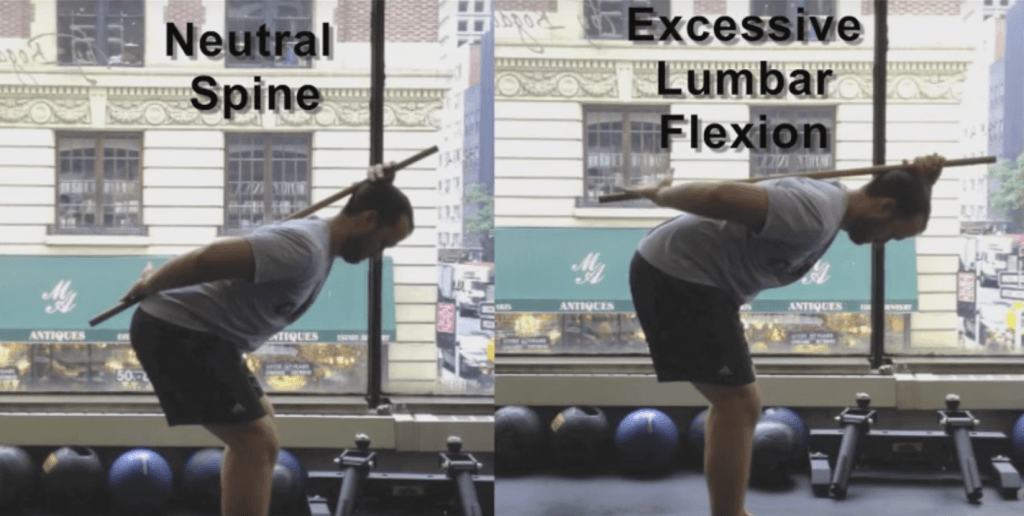
Hip Hinge Dowel Test from Aaron Swanson via Youtube
In the image above, on the left you can see what it means to keep a neutral spine.
This is opposed by lumbar flexion on the right which is what you get when your hips are too tight.
Many players lack sufficient flexibility in hip flexors and adductors.
Improving this hip flexibility lays the foundation for improved athleticism and is the key to reaching elite levels.
If you you found value with today’s post please like, comment and share.
Play Big!

Coach Steve











